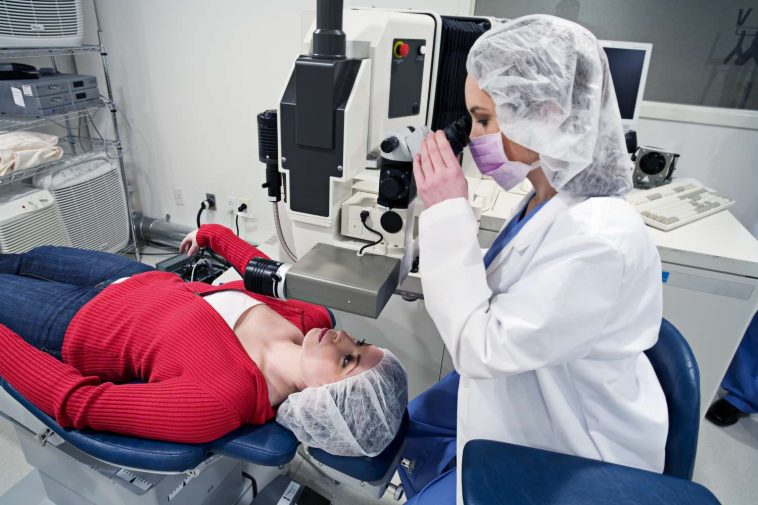Corrective eye surgery is an umbrella term for a number of surgical procedures aimed at correcting various vision problems such as myopia (nearsightedness), hyperopia (farsightedness), astigmatism, and presbyopia. All of these errors are caused by an error in the refractive power of the cornea.
Due to factors such as looking at screens for long durations, trauma, or age, the cornea can get misshaped. Once that happens, the light rays entering the eyes are not resolved right on the retina. Instead, they focus slightly in front of the retina (nearsightedness) or beyond the retina (or don’t resolve completely at all, hyperopia).
There are multiple surgical procedures used to correct these issues all with their own pros and cons. In this guide, we’re going to look at LASIK, PRK, LASEK, SMILE, and ICL corrective eye surgery (refractive lensectomy). The aim of all of these surgeries is to correct visual acuity and provide a shaper, clearer sight without the need for contact lenses or eyeglasses.
For the best diagnosis and the most suitable treatment for you, you’re recommended to get in touch with a specialist from a reputable eye clinic like Discover Eye Vision.
1. LASIK
LASIK (Laser-Assisted in Situ Keratomileusis) is a popular, widely performed, and dependable eye surgery procedure with a high success rate. It barely takes a few minutes per eye and the recovery period is very short. There’s also no to negligible discomfort after the surgery. All of this makes it a better option than others like PRK.
On the downside, LASIK is usually more expensive than PRK, SMILE, and many other options.
In this procedure, a thin flap is created on the cornea to access the underlying tissue. Using lasers, microscopic amounts of corneal tissue are then removed to reshape the cornea and fix the refractive error. Once done, the flap is repositioned and the healing process begins.
It’s important to follow all guidelines and keep the eyes protected from trauma and rubbing of any kind until the flap adheres completely.
Flaps cannot be created on the cornea if it’s too thin or irregularly shaped. Incidentally, not everyone is eligible for LASIK treatment.
2. PRK
PRK (Photorefractive Keratectomy) is a cheaper option that’s also quite reliable. In this, the entire outer layer of the cornea, called epithelium, is removed. This removal process causes some discomfort.
The rest of the process is pretty much the same as LASIK—Small amounts of corneal tissue are removed to reshape the cornea. Once done, a protective contact lens is placed on the eye until the epithelium regenerates naturally.
PRK takes longer to fully stabilize. It can take days if not weeks before the epithelium fully regenerates. As this process creates no flap that has to be protected, it’s generally considered to be safer than LASIK.
3. LASEK
LASEK (Laser Epithelial Keratomileusis) is a variation of PRK. Instead of creating a flap like in LASIK, this process uses an alcohol solution to loosen the epithelium. Whereas the epithelium is removed using a laser in PRK, it’s only dislodged and moved to the side of the eye in LASEK. The remainder of the process is, again, the same—The cornea is reshaped.
In many ways, it’s the best of LASIK combined with that of PRK.
People with thin corneas, severe nearsightedness, and underlying medical conditions are often ineligible for LASIK. That’s not the case with LASEK, and incidentally, dry eyes are less common in LASEK compared to LASIK. And unlike PRK, there’s little to no discomfort as the epithelium is not removed.
The only downside? LASEK’s recovery time is longer and a little more discomforting than LASIK’s.
4. SMILE
SMILE (Small Incision Lenticule Extraction) is another eye surgery that can correct refractive errors, specifically myopia. SMILE is a comparatively newer minimally invasive procedure.
A femtosecond laser creates a small incision in the cornea and then a piece of corneal tissue is removed through this incision, thus altering the cornea’s shape.
As it requires a very small incision, the healing is faster and the risk of complications is lower, compared to LASIK. SMILE also preserves more of the corneal structure as it doesn’t involve creating a flap, which is generally considered good.
5. Refractive Lensectomy
In some cases, you might not be suitable for any of the above. This mainly happens when the cornea is extremely thin or the condition is very severe. Implantable lenses can be used in these cases.
Refractive lensectomy, lens replacement surgery, or clear lens extraction are all different names for the same procedure. In this procedure, an artificial intraocular lens (IOL) is placed inside the eye, replacing the natural lens.
A small incision is made in the cornea, and the natural lens is either fragmented and suctioned out or removed in one piece.
Once the natural lens is removed, an artificial intraocular lens is implanted into the eye. The lens is carefully selected to match the desired refractive correction, and it can be a monofocal lens, multifocal lens, or accommodating lens, depending on the individual’s needs and preferences.
Refractive lensectomy cost is usually in the range of $4000 to $10,000 per eye.
Wrapping Up
Hopefully, our guide to all five major eye surgery procedures helped you better understand how they work and their benefits. Not all surgeries are recommended for everyone. For example, if your cornea is very thin or irregularly shaped, LASIK cannot be performed as no flap can be created safely.
Make sure you consult with an ophthalmologist or an eye specialist from a clinic before you move ahead with any surgery. A thorough evaluation is very important to determine your suitability for a particular eye surgery.



